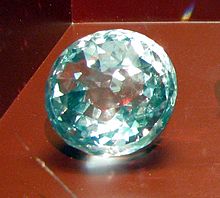Great Mogul Diamond
 A replica of theGreat Moghul Diamond | |
| Weight | 280carats(56 g) |
|---|---|
| Country of origin | India |
| Mine of origin | Kollur Mine |


TheGreat Mogulwas a large diamond that is believed to have been discovered around 1650, most probably around theKollur Minein the Golconda region of southern India.Tavernierdescribed the diamond thus: "The stone is of the same form as if one cut an egg through the middle".[1]
History[edit]
The 787-carat (157.4 g)[1]rough diamond was gifted by Emir Jemla toShah Jahan,the 5thMughal emperor,as part of diplomacy between the two families.[2][3]
Jemla described it as "that celebrated diamond which has been generally deemed unparalleled in size and beauty."[4]
A Venetianlapidarynamed Ortensio Borgio was assigned to cut the stone. It is believed that the Great Mogul Diamond exhibited severalinclusions.Rejecting the idea of cutting the diamond into several fine stones, Borgio decided to address the inclusion problem by grinding away at it until the unwanted flaws were gone. Much to the horror of the Emperor, Borgio's work yielded very poor results, including a great loss of weight. Shah Jehan spared Borgio's head, instead fining him 10,000 rupees (all the money he had) for his ineptitude. Originally this story was believed to refer to theKoh-i-Noor Diamond;recent research appears to indicate that it instead refers to this stone.[5]
Around 1665 the Shah's son,Aurangzeb,showed the stone to the famous jeweler and world travelerJean Baptiste Tavernier.At that time Tavernier wrote in his Six Voyages: "The first piece that Akel Khan (Chief Keeper of the King's jewels) placed in my hands was the great diamond, which isrose cut,round and very high on one side. On the lower edge there is a slight crack, and a little flaw in it. Its water is fine, and weighs319+1⁄2ratis, which makes 280 of our carats, the rati being7⁄8thof a carat. "[6]
Later, the Great Mogul Diamond was transferred toLahore Subahand became part of the spoils of war whenMughal Indiawas invaded andLahoreand thenDelhisacked by the Persian rulerNadir Shah.Nadir Shah returned with the stone to his home inIsfahanin 1739 from the Nawabs of Punjab. However, Nadir Shah's ownership proved short-lived. He was assassinated in 1747 and the stone disappeared.[citation needed]
Most modern scholars are now convinced that the Great Mogul is actually theOrlov Diamond,today part of Catherine the Great's imperial Russian sceptre in theKremlin.[7]
The Great Mogul in fiction[edit]
- Sir Arthur Conan Doyle's novelThe Sign of the Fourhas the ex-convict Jonathan Small stealing a treasure stash containing the Great Mogul twice—once in 1857, and finding and stealing it again in 1888—only to throw it into theRiver Thamesbefore being captured bySherlock Holmesand the police.
- In the 1898 science fiction novelEdison's Conquest of Mars,the King ofSiamproduces the Great Mogul to help fund the invasion of Mars.
- Bangladeshi writerQazi Anwar Hussainused the stone in his writing. His most famous fictional character, Masud Rana, finds it and many other historical materials in the bookI Love You, Man.The story is about finding the materials and facing the dangers.
See also[edit]
References[edit]
- ^abSpring 1941, Important Diamonds of the World - The Great Mogul; Star of South Africa (or Dudley), Robert M Shipley, p. 143, 2pp.
- ^"George John Younghusband - The jewel house: an account of the many romances connected with the royal regalia, Page 9".Archivedfrom the original on 25 June 2020.Retrieved14 November2012.
- ^"Great Mogul Diamond | Antique Jewelry University".Archivedfrom the original on 9 November 2012.Retrieved14 November2012.
- ^Orpen, Mrs. Goddard. Stories about Famous Precious Stones Boston: D. Lothrop Company, 1890. pp. 204
- ^"Koh-i-Noor: Six myths about a priceless diamond".BBC News.9 December 2016.Archivedfrom the original on 10 September 2017.Retrieved2 August2018.
- ^Streeter, Edwin W. The Great Diamonds of the World: Their History and Romance London: George Bell and Sons, 1882. pp. 69-72
- ^"Koh-i-Noor: Six myths about a priceless diamond".BBC News.9 December 2016.Archivedfrom the original on 10 September 2017.Retrieved16 November2020.
Further reading[edit]
- Malecka, Anna (2016), The Great Mughal and the Orlov: One and the Same Diamond? The Journal of Gemmology, vol. 35, no. 1, 56-63.
